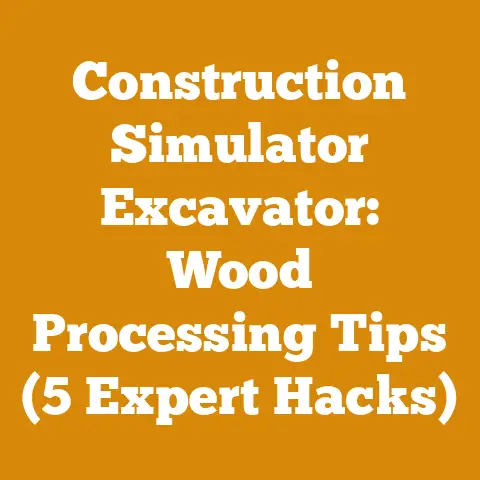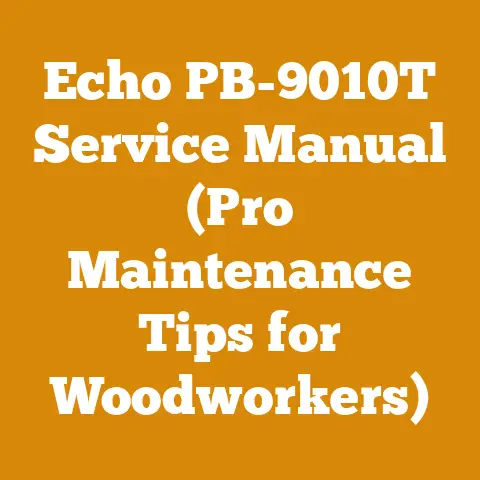Chainsaw Engine Go Kart Build (5 DIY Tips for Woodworkers)
Alright, let’s dive into the exciting world of building a chainsaw engine go-kart! I’ve spent years tinkering with engines, felling trees, and crafting firewood, and I can tell you, the idea of harnessing a chainsaw’s power for a go-kart is pure genius. It’s a project that blends ingenuity, woodworking skills, and a dash of adrenaline. This guide is designed to walk you through the process, offering insights, tips, and precautions to make your DIY journey a success.
Chainsaw Engine Go-Kart Build (5 DIY Tips for Woodworkers)
For many of us, the allure of building something from scratch is deeply satisfying. I still remember the first time I repurposed an old lawnmower engine for a mini-bike as a kid. The thrill of that sputtering engine roaring to life was unforgettable. Building a chainsaw engine go-kart offers a similar experience, combining practical skills with the sheer joy of creation. Plus, if you’re like me, you’ve probably got a spare chainsaw kicking around, just waiting for a new purpose.
1. Understanding the Project Scope: Is a Chainsaw Engine Go-Kart Right for You?
Before you even think about touching a wrench or grabbing a piece of wood, it’s crucial to understand what you’re getting into. Building a go-kart, especially one powered by a chainsaw engine, is not a weekend project. It requires time, patience, and a decent amount of mechanical aptitude.
- Skill Level Assessment: Are you comfortable with basic woodworking? Can you handle metal fabrication, even if it’s just drilling and bolting? Do you have experience with small engines? If the answer to any of these questions is a resounding “no,” don’t despair! This project can be a fantastic learning opportunity. However, be prepared to invest extra time in research and possibly seek guidance from experienced friends or mentors.
- Tool Inventory: A well-equipped workshop is essential. I’m talking about having the right tools for cutting, drilling, welding (if you choose to weld), and assembling. A basic list includes:
- Chainsaw disassembly tools (wrenches, screwdrivers, pliers)
- Welding machine (optional, but highly recommended)
- Angle grinder with cutting and grinding discs
- Drill press or heavy-duty drill
- Metal cutting saw (bandsaw or reciprocating saw)
- Woodworking tools (saw, drill, measuring tools)
- Safety gear (gloves, eye protection, ear protection)
- Time Commitment: Realistically, expect to spend at least 40-60 hours on this project. This includes research, design, sourcing materials, fabrication, and testing. I remember one time thinking I could rebuild a small engine in a weekend, only to find myself still tinkering with it a week later.
- Budget Considerations: The cost of materials can vary widely depending on what you already have on hand and the quality of components you choose. A conservative estimate would be between $200 and $500. This includes the cost of the go-kart frame (if you’re not building one from scratch), wheels, axles, steering components, and any necessary hardware. I once tried to cut corners on a project like this, and ended up spending more in the long run replacing cheap parts.
Takeaway: Honestly assess your skills, resources, and time availability. A chainsaw engine go-kart is a rewarding project, but it requires commitment.
2. Chainsaw Selection and Engine Preparation: Choosing the Right Power Plant
The heart of your go-kart is, of course, the chainsaw engine. But not all chainsaws are created equal. Choosing the right one can make or break your project.
- Engine Size and Power: I recommend using a chainsaw with an engine displacement of 40cc to 60cc. This provides a good balance of power and manageable size. Larger engines can be overkill and may require significant modifications to the go-kart frame. Smaller engines might struggle to provide adequate torque, especially on inclines.
- Chainsaw Type: A standard two-stroke chainsaw is ideal. Avoid electric chainsaws, as they lack the necessary power and durability for this application. I’ve seen people try to adapt electric motors for similar projects, but the results are rarely satisfactory.
- Engine Condition: Ideally, you want a chainsaw with a healthy engine. A compression test is a good way to assess the engine’s condition. A healthy two-stroke engine should have a compression reading of at least 100 PSI. I once tried to use an engine with low compression, and it was a constant headache trying to keep it running.
- Engine Removal and Cleaning: Carefully remove the engine from the chainsaw housing. This usually involves disconnecting fuel lines, throttle cables, and any electrical connections. Thoroughly clean the engine to remove any dirt, grease, or sawdust. A clean engine is easier to work on and will help prevent future problems. I like to use a degreaser and a stiff brush for this task.
- Engine Inspection: Inspect the engine for any signs of damage or wear. Check the cylinder walls for scoring, the piston for cracks, and the connecting rod for play. Replace any worn or damaged parts before proceeding. It’s better to address these issues now than to have them cause problems later.
Takeaway: Choose a chainsaw with a healthy engine in the 40cc-60cc range. Thoroughly clean and inspect the engine before starting the build.
3. Go-Kart Frame Design and Construction: Building a Solid Foundation
The frame is the backbone of your go-kart. It needs to be strong, stable, and capable of withstanding the stresses of driving. You have two main options: build a frame from scratch or modify an existing one.
- Building a Frame from Scratch: This option gives you the most flexibility in terms of design and dimensions. However, it also requires more time, skill, and equipment. If you choose to build your own frame, I recommend using steel tubing with a wall thickness of at least 1/8 inch. A common size is 1-inch square tubing.
- Design Considerations: Consider the overall dimensions of the go-kart, the placement of the engine, seat, and steering components, and the desired wheelbase and track width. A longer wheelbase will generally provide more stability, while a wider track width will improve handling. I like to sketch out a detailed design on paper before starting any cutting or welding.
- Welding Techniques: If you’re welding the frame, be sure to use proper welding techniques. Clean the metal thoroughly before welding, and use a welding process that is appropriate for the type of steel you’re using. I prefer MIG welding for its ease of use and clean welds. Always wear appropriate safety gear when welding, including a welding helmet, gloves, and a respirator.
- Modifying an Existing Frame: This option can save you a significant amount of time and effort. You can often find used go-kart frames for sale online or at local scrap yards. When modifying an existing frame, be sure to reinforce any areas that may be weakened by cutting or welding.
- Frame Geometry: The frame geometry is critical for handling and stability. Pay close attention to the caster, camber, and toe angles of the front wheels. These angles can significantly affect the go-kart’s steering and handling characteristics. I recommend researching these concepts online or consulting with an experienced go-kart builder.
- Safety Considerations: The frame should be designed to protect the driver in the event of a crash. Consider adding roll bars or other safety features to the frame. Pay close attention to frame geometry and safety considerations.
4. Drivetrain Integration: Connecting the Engine to the Wheels
This is where the magic happens – transferring the power from the chainsaw engine to the go-kart’s wheels. This involves some ingenuity and adaptation.
- Clutch System: Chainsaws typically don’t have a traditional clutch. Instead, they use a centrifugal clutch that engages automatically when the engine reaches a certain RPM. You’ll need to adapt this clutch to work with the go-kart’s drivetrain.
- Direct Drive: One option is to use a direct drive system, where the chainsaw clutch is directly connected to the axle. This is the simplest approach, but it can be jerky and difficult to control at low speeds. I tried this once and found it challenging to manage the go-kart in tight spaces.
- Jackshaft System: A better option is to use a jackshaft system. A jackshaft is an intermediate shaft that allows you to adjust the gear ratio between the engine and the axle. This provides better control and allows you to optimize the go-kart’s performance for different terrains. I highly recommend this approach.
- Gear Ratio Selection: The gear ratio is the ratio between the number of teeth on the engine sprocket and the number of teeth on the axle sprocket. A lower gear ratio (e.g., 3:1) will provide more torque, while a higher gear ratio (e.g., 5:1) will provide more speed. I recommend experimenting with different gear ratios to find the optimal balance for your needs.
- Chain and Sprocket Selection: Use a high-quality chain and sprockets that are designed for go-kart applications. A common chain size is #35 or #40. Be sure to properly align the sprockets to prevent chain slippage and wear. I always use a chain alignment tool to ensure proper alignment.
- Axle and Bearings: Use a sturdy axle that is designed for go-kart applications. A common axle size is 1 inch in diameter. Use high-quality bearings to ensure smooth and reliable operation. I recommend using sealed bearings to prevent dirt and debris from entering the bearings.
- Braking System: A reliable braking system is essential for safety. I recommend using a disc brake system. Disc brakes provide more stopping power than drum brakes and are less prone to fading under heavy use. Be sure to properly bleed the brakes to remove any air from the brake lines.
Takeaway: Use a jackshaft system to optimize the gear ratio between the engine and the axle. Choose high-quality components for the drivetrain and braking system.
5. Steering and Controls: Putting You in Command
The steering and controls are what allow you to actually drive and control the go-kart. This is another area where careful planning and execution are essential.
- Steering System: There are several different types of steering systems that you can use for your go-kart. A common option is a rack and pinion steering system. Rack and pinion systems provide precise and responsive steering. Another option is a simple steering linkage system. This type of system is less expensive and easier to build, but it may not provide as precise steering.
- Steering Wheel and Column: Choose a steering wheel that is comfortable to grip and that is the appropriate size for your go-kart. The steering column should be securely mounted to the frame and should be positioned at a comfortable angle. I prefer a steering wheel with a diameter of around 12 inches.
- Throttle Control: You’ll need to adapt the chainsaw’s throttle control to work with the go-kart. This usually involves connecting a throttle cable to the carburetor and mounting a throttle lever on the steering wheel or near the seat. Be sure to properly adjust the throttle cable to ensure smooth and responsive throttle control. I like to use a motorcycle throttle lever for its comfortable grip and precise control.
- Brake Pedal: The brake pedal should be positioned within easy reach of your foot. Be sure to properly adjust the brake linkage to ensure that the brakes are applied evenly and smoothly. I recommend using a hydraulic brake system for its superior stopping power.
- Seat and Safety Harness: Choose a seat that is comfortable and provides adequate support. A racing seat is a good option for its supportive design. Install a safety harness to keep you securely in the seat in the event of a crash. I always wear a helmet and safety harness when driving any type of go-kart.
- Testing and Adjustments: Once you’ve completed the build, thoroughly test the go-kart in a safe and controlled environment. Check the steering, brakes, and throttle control. Make any necessary adjustments to ensure that the go-kart is operating safely and smoothly. I always start with slow speed tests and gradually increase the speed as I become more comfortable with the go-kart’s handling.
Takeaway: Choose a steering system that provides precise and responsive steering. Install a comfortable seat and safety harness. Thoroughly test and adjust the go-kart before driving it at high speeds.
Additional Tips and Considerations
- Safety First: Always wear appropriate safety gear when working on or driving your go-kart. This includes eye protection, ear protection, gloves, a helmet, and a safety harness.
- Research and Planning: Thoroughly research and plan your project before starting any work. This will help you avoid costly mistakes and ensure that your go-kart is built safely and correctly.
- Seek Expert Advice: Don’t be afraid to seek advice from experienced go-kart builders or mechanics. They can provide valuable insights and help you troubleshoot any problems that you may encounter.
- Be Patient: Building a chainsaw engine go-kart is a challenging project that requires time and patience. Don’t get discouraged if you encounter setbacks. Just keep learning and keep working towards your goal.
- Have Fun: Building a go-kart should be an enjoyable experience. Don’t take it too seriously and remember to have fun along the way.
Woodworking Integration
As a woodworker, you can incorporate your skills into various aspects of the go-kart build:
- Seat Construction: Design and build a custom wooden seat for your go-kart. You can use plywood, hardwood, or even reclaimed wood. Consider adding padding and upholstery for comfort. I once built a seat out of reclaimed barn wood and it added a unique rustic touch to the go-kart.
- Body Panels: Create custom body panels for your go-kart using wood. This can add a unique and stylish look to your creation. You can use plywood, cedar, or other lightweight woods. Be sure to seal and protect the wood from the elements.
- Steering Wheel: Craft a custom wooden steering wheel for your go-kart. This can be a challenging but rewarding project. Use hardwoods like oak or maple for durability.
- Dashboard: Build a wooden dashboard to house gauges and switches. This can add a professional and functional touch to your go-kart.
- Tool Holders: Design and build custom tool holders for your workshop to keep your tools organized and accessible.
Case Study: My First Chainsaw Engine Go-Kart
I built my first chainsaw engine go-kart about 10 years ago. I used an old 50cc chainsaw engine that I had lying around. I built the frame from scratch using steel tubing. I used a jackshaft system to connect the engine to the axle. I also installed a disc brake system for safety. The go-kart was a blast to drive, but it had some limitations. The engine was a bit underpowered, and the steering was not very precise. However, it was a great learning experience and it inspired me to build more go-karts in the future.
Common Mistakes to Avoid
- Using an Undersized Engine: Don’t try to use a chainsaw engine that is too small for the go-kart. This will result in poor performance and a frustrating driving experience.
- Neglecting Safety: Always prioritize safety when building and driving your go-kart. Wear appropriate safety gear and thoroughly test the go-kart before driving it at high speeds.
- Cutting Corners: Don’t try to cut corners on materials or construction. This will likely result in a poorly built and unreliable go-kart.
- Ignoring Frame Geometry: Pay close attention to frame geometry. This is critical for handling and stability.
- Failing to Test: Thoroughly test the go-kart before driving it at high speeds. This will help you identify and correct any problems.
Conclusion
Building a chainsaw engine go-kart is a challenging but rewarding project that combines woodworking skills with mechanical ingenuity. By following these tips and precautions, you can build a safe and fun go-kart that will provide you with hours of enjoyment. Remember to prioritize safety, plan carefully, and don’t be afraid to seek expert advice. And most importantly, have fun! I hope this guide has provided you with the information and inspiration you need to get started on your own chainsaw engine go-kart project. Now, go out there and build something amazing!
- Clutch System: Chainsaws typically don’t have a traditional clutch. Instead, they use a centrifugal clutch that engages automatically when the engine reaches a certain RPM. You’ll need to adapt this clutch to work with the go-kart’s drivetrain.






